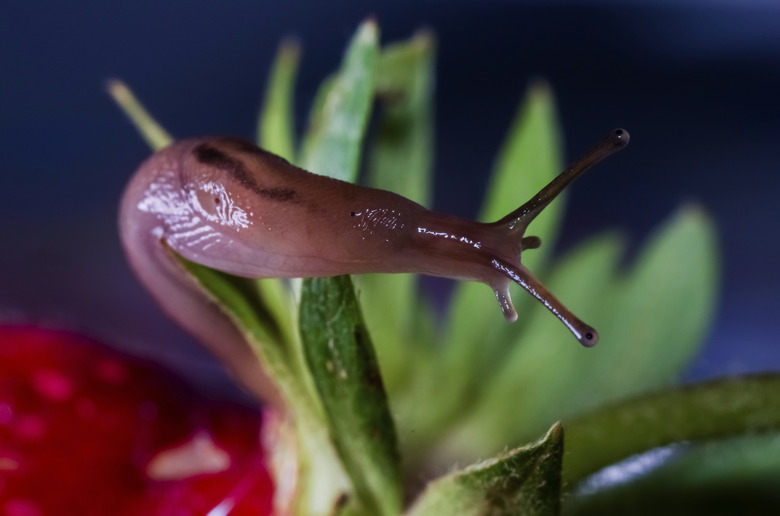How To Get Rid Of Snails And Slugs Naturally
To get rid of those pesky snails and slugs in your garden without the use of chemical treatments, start by removing the pests by hand, searching them out in the evening. Doing that chore daily at first, and then weekly as the population dies down, will reduce the numbers. Because a multifaceted approach is usually best, also try cleaning the area, adding barriers around your plants and setting out natural traps.
Prevent Excess Moisture
Snails and slugs like damp or moist environments, and often hide in the damp areas under boards, plant debris and mulch. Thus, one way to keep the area free from excess moisture is to install a drip irrigation or underground irrigation system instead of doing overhead watering. In general, good air flow will keep the moisture down, so also keep your plants pruned to encourage good air flow.
Remove Hiding Spots
Also, look through your garden and remove any boards, thick mulch or debris where slugs and snails can hide. If you have wood or other surfaces you can't remove — such as nearby deck boards, for example — check them regularly for slugs. You can also set out a moist board as a "trap" for the pests, making sure to check under the board every day to remove any slugs or snails you find.
- To get rid of those pesky snails and slugs in your garden without the use of chemical treatments, start by removing the pests by hand, searching them out in the evening.
- Also, look through your garden and remove any boards, thick mulch or debris where slugs and snails can hide.
- If you have wood or other surfaces you can't remove — such as nearby deck boards, for example — check them regularly for slugs.
Kill Slugs Naturally
Slugs and snails also love yeast, so another way to trap them is to set out a container of a yeast-containing substance. Use beer or a solution of 1 teaspoon of yeast to 3 ounces of water, suggests the University of Minnesota Extension website. Cut several old yogurt container or other plastic containers to about 1 inch high and dig shallow holes in your garden. Set the containers into the holes, flush with the soil line. Fill the container with the yeast-containing liquid and check the traps for slugs in the morning.
Also try creating a garlic-based spray as a natural pesticide that works on slugs, suggests the World Agroforestry Centre. Fill a spray bottle with 10 liters of water and three finely chopped garlic bulbs, and then spray your plants every three days with the solution. You can also try setting a jar of oat bran on its side near the garden. When slugs eat the oat bran, it expands in their bodies and kills them, explain master gardeners Frank and Linda Saus of Penn State Extension-Beaver County.
- Slugs and snails also love yeast, so another way to trap them is to set out a container of a yeast-containing substance.
- Use beer or a solution of 1 teaspoon of yeast to 3 ounces of water, suggests the University of Minnesota Extension website.
Create a Barrier
Another option is to create a barrier that slugs and snails can't cross. Wrap copper tape or copper bands — found at garden supply stores — around the stems of your plants or your garden bed. Copper can cause a disruption in a snail or slug's nervous system as it crosses it, according to the University of California's Statewide Integrated Pest Management System. One thing to keep in mind, though: If you plan to place a copper strip around an entire raised bed garden, the bed needs to be free of slugs before installation.
Some gardeners also sprinkle diatomaceous earth around their plants to repel slugs, but the effectiveness wears off as soon as the diatomaceous earth gets wet. Also avoid adding salt to your garden to kill slugs, as it can affect your soil health. There's also no evidence to support using Epsom salts against slugs, suggests Dr. Linda Chalker-Scott of the Washington State University Puyallup Research and Extension Center.
- Another option is to create a barrier that slugs and snails can't cross.
- Wrap copper tape or copper bands — found at garden supply stores — around the stems of your plants or your garden bed.
- Copper can cause a disruption in a snail or slug's nervous system as it crosses it, according to the University of California's Statewide Integrated Pest Management System.
References
- University of California Agriculture & Natural Resources: Statewide Integrated Pest Management Program: Snails and Slugs
- University of Minnesota Extension: Slugs in Home Gardens
- North Carolina Cooperative Extension: Slugs & Snails
- Washington State University: "Adding Epsom Salts to Gardens Is a Safe, Natural Way to Increase Plant Growth"
- World AgroForestry Centre: Appendix 2: Natural Pesticide Recipes
- The Times Online: How to Discourage or Remove Slugs From the Garden
